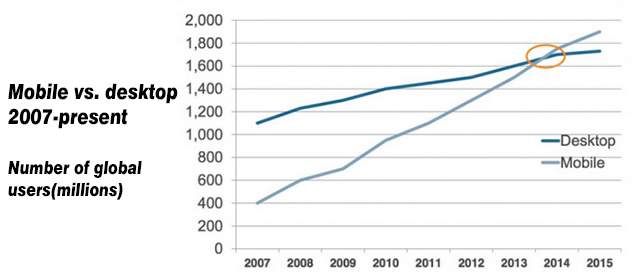As of the 21st April 2015 Google are altering their mobile search algorithm in order to determine whether or not your site is mobile-friendly and responsive. If you don’t fall under these categories then you will likely see quite a drop in your SEO rankings, meaning that if you were considering shifting your web site to responsive, now really is the time to act. Alternatively, if your web site is already mobile-friendly or responsive then your SEO might really benefit from this change.
The Google update – as outlined here on the official Google webmaster blog – will run in real-time and will be determinable on a page by page account. Meaning that as soon as your page has been crawled by the Googlebots the SEO benefits/disadvantages will take immediate action. It also means that if only 2/5 of your pages are mobile-friendly and the others are not then only those pages will be affected by this change.
Google are really clamping down on websites that do not address the UX and they are making it impossible to ignore the protocol on web site usability.
This newest SEO ranking change has been created specifically with those points in mind and we predict that the non-responsive site will soon be a relic of web design history. If you would like to find out more about the responsive web format, read our blog titled Responsive web design: Just say yes! (We told you so!)

This latest update from Google will only be relevant on searches made from mobile devices or tablets and not those made on desktops. This update is aimed to improve the mobile-users search results, pushing mobile-friendly sites to the top of SEO rankings, meaning that their user-experience will be optimised to the highest quality no matter where they are searching from.
Of course this is good news for users however a lot of businesses are under pressure to make the change (within the next 3 weeks!) to prevent their businesses from falling by the wayside.
How are Google preparing us for the change?
Google often release these kinds of updates without any formal introduction. Sometimes they happen gradually in order to provide a true analysis of user behaviour and other times they offer support in order for web developers to develop strategies to deal with the change.
If you are not sure where your site fits in with these updates then Google have provided a Mobile-Friendly test. Just add your website URL and Google will let you know whether you are mobile-friendly and what changes you need to make if you aren’t.
Webmaster tools also provide a mobile-usability report in their traffic menu, which will determine any problems that mobile site users might come across when visiting your site.
In response to the back-lash of website owners contacting webmaster and tweeting their confusion surrounding the mobile-friendly SEO update, Google compiled a list which relates to the most common mobile-friendly mistakes. These apply to those thinking of updating their websites to mobile-friendly and those with existing mobile-friendly sites and how to make the most of this Google update.
Things that could affect the new mobile-friendly algorithm
-
- Blocked JavaScript, CSS and image files: In order for Googlebot to see your site as a real user would, always allow access to these files in your site’s robots.txt.
-
- Unplayable content: This consists of certain types of videos, or other content, that are not playable on mobile devices, such as license-constrained media or media that requires Flash.
-
- Faulty redirects: If you have separate mobile URLs, you must redirect mobile users on each desktop URL to the appropriate mobile URL.
-
- Mobile-only 404s: Some sites serve content to desktop users accessing a URL but show an error page to mobile users. Instead, redirect mobile users to an equivalent mobile page to avoid 404s.
-
- App download interstitials: This is when websites block the view of pages with a prompt to download the site’s native app. Instead, use a small HTML banner at the top of the page.
-
- Irrelevant cross-links: This is when users are linked to desktop-optimized pages from the mobile version of the site, and vice versa. Check your links to make sure that they point to the correct equivalent page.
-
- Slow mobile pages: In order to avoid user frustration, ensure your mobile pages load quickly. You can check your page speed with Google PageSpeed Insights.
Take heed…
This algorithm is of particular importance right now, especially for ecommerce websites and other businesses that rely mainly on web sales. The change will be of ‘significant importance’ in the SEO rankings according to Google however it is yet to be determined just exactly how the hierarchy will be presented amongst non mobile-friendly sites.

If you would like us to migrate your existing site to a responsive mobile-friendly format then please get in touch.
View our portfolio of responsive sites here.


